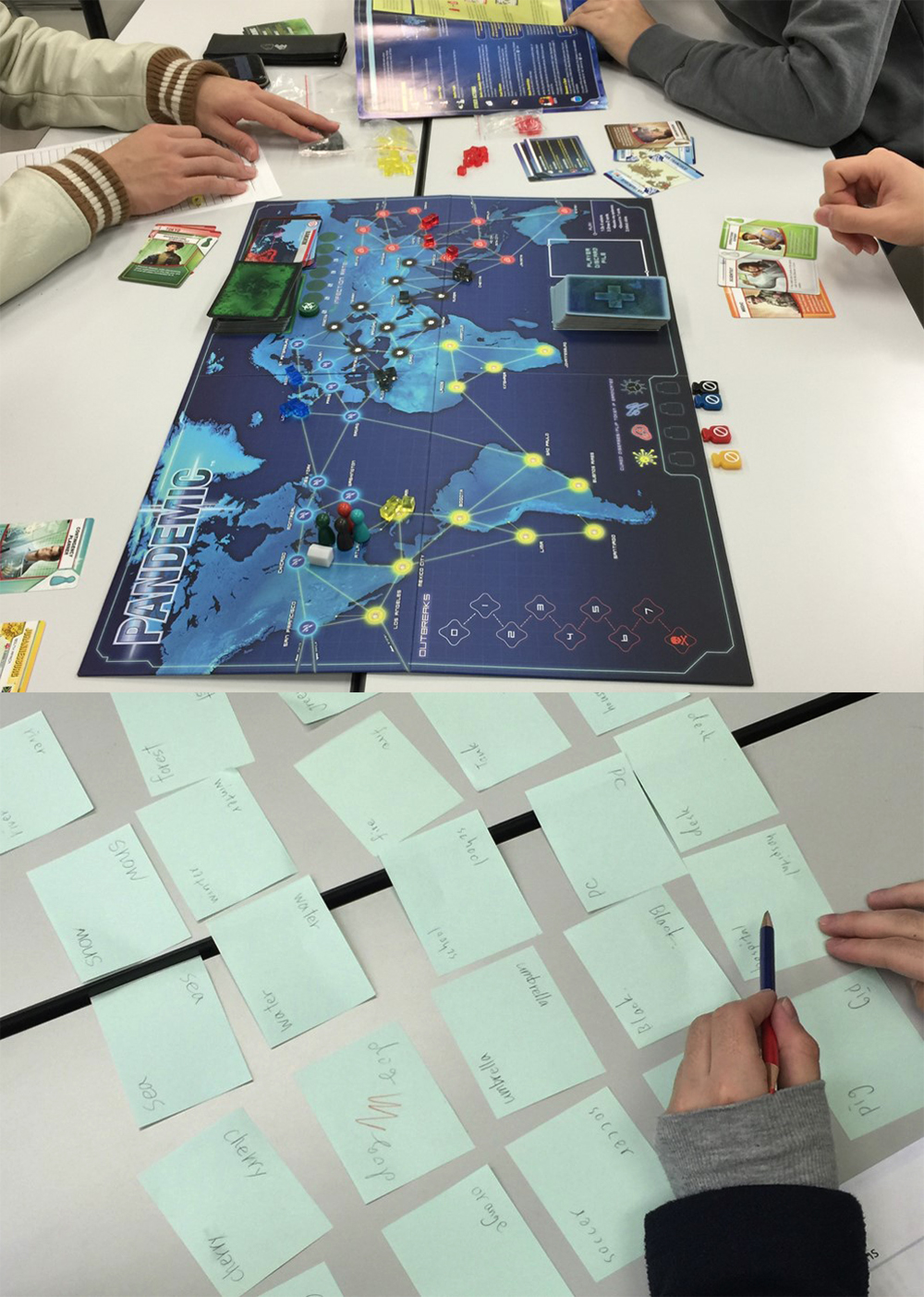平成28年度 PBL教育支援プログラム 成果報告書「英語Ⅳ」
2017.07.13
| 開講学部 | 理工学部 |
| 科目名 | 英語Ⅳ |
| 担当教員 | ヨーク・ジェームズ |
Q1 PBLを導入した意図・目的
Interaction provides numerous benefits for the development of communicative competence in a foreign language. Therefore, promoting students to work in groups during class is one way to promote interaction, and accordingly foreign language development. Framing classes from a PBL perspective provides the additional benefits of 1) engaging students in the class, 2) promoting students to be responsible for their own learning, 3) providing concrete aims that span multiple, successive classes.
Q2 授業におけるPBLの実践方法
Cooperative board games were used as the core teaching materials for this implementation of PBL.
At the start of the course, a list of board games was provided to students. In groups, they researched various aspects of the games (theme, mechanics, number of players, difficulty, etc.) with the aim of finding a game that they would personally like to play. Upon choosing which game they wanted to play individually, students made groups with others interested in playing the same game. Thus, a number of small groups were created based on students’ game preferences.
Following, I provide the general framework for how students worked on the “problem” of playing a board game with others in English.
Before playing the game, students need to learn the rules of the game. Additionally, they need to equip themselves with appropriate vocabulary and grammar in order to successfully play the game in English. Due to time limitations in class, the pre-play phase of this approach to PBL is divided into extracurricular (homework) and classroom-based activities. Note that by putting students in charge of learning rules for themselves, it is possible to promote them to be responsible for their own learning.
Extracurricular pre-play activities
1. Learn the rules to the game.
2. Make comprehension questions regarding game rules
Classroom-based pre-play activities
1. Check rules with other students using comprehension questions
2. Scan rulebook for useful vocabulary
Upon completing these activities, students are in a position to play the game. Gameplay typically lasts 45 minutes during class time, during which students are asked to keep a record of any new vocabulary they hear, as well as any phrases that they would like to have said but did not have the language skills to produce.
The play session is recorded and students transcribe this recording for homework by delegating certain sections of the recording to each member (such as by dividing the audio into 5-minute segments). The transcriptions are then analysed in future classes to look for 1) English mistakes and 2) unnecessary Japanese usage.
The main post-play activity is for students to create a report of the gameplay session. They are told that their reports will be made available to future students to help them make decisions regarding which game to play, and they language they will need to play it. There are five different kinds of report that students can complete:
1.Create a gameplay video
2.Create a rules introduction video
3.Write a game review
4.Create a transcription of gameplay discourse
5.Teach other students in the class how to play the game.


Q3 授業における成績評価方法
Weekly class participation 50%
Final project 50%
Q4 学習成果の可視化の取組み
In order to make learning gains visible, students go through a process of transcribing their play sessions and analyzing their utterances for mistakes and Japanese usage, thus improving their interlanguage and equipping themselves with additional vocabulary and grammar for a second play session. They are also advised to consider what phrases and grammatical constructs are important for playing the game, and to create example sentences for use in the second play session. Upon completing the second gameplay session, they repeat the process of transcription and analysis. Now, with two transcriptions available to them, students are able to compare their linguistic performance during gameplay.
Additionally, they have completed a cycle of being a learner of the game, to a player of the game and finally to a stage of master of the game. At this stage, they create content for other students, thus, they are able to see their progression from learner to master.
Q5 PBLを発展させるための課題
Students at TDU are not familiar with a PBL approach to learning, and thus preparing them to work in this manner can be difficult.
Q6 授業の概要と進め方
The framework is comprised of six parts. Each part is one 90-minute class.
1.Learn the rules
2.Play
3.Analyse a transcription of gameplay discourse
4.Play again
5.Analyse gameplay discourse and compare with previous play session
6.Complete a final project reflecting on the experience
〇PBLを主体とした教育への取組みに対する支援(PBL教育支援プログラム学内公募)
東京電機大学教育改善推進室では、平成23年度から「学生が主体となって学ぶ」形式を取り入れた、いわゆる「PBL(Problem-Based Learning又はProject-Based Learning)」による教育の開発・運営を「PBL教育支援プログラム」として支援し推進しています。
PBL教育支援プログラムは、これからPBLを取り入れていこうと考えている教員やすでに実践しているPBLをさらに工夫しようと考えている科目を対象に支援を行い、その実践と成果を学内の関係者と共有し、学生の学びを主体とした教育の推進を図ることを目的としています。
- 大学紹介
- 基本情報
- 学長挨拶
- 顧問学長対談
- 副学長・学部長等 役職者
- 建学の精神と教育・研究理念
- 東京電機大学大学院・大学の3つのポリシー
- 大学のあゆみ
- 大学の取り組み
- 情報公開
- 認証評価、自己点検・評価
- ホームカミングデー
- 東京電機大学が求める教員像
- 教育関係附置施設
- キャンパス紹介
- 東京電機大学大学のアセスメント・ポリシー
- 学園紹介
- 学校法人東京電機大学概要
- 理事長挨拶
- 理事・監事
- 評議員
- 事業・財務情報
- ガバナンス
- 学園創立100周年宣言
- 学園広報物
- TDUコメンテーター教員紹介
- 学園へのご寄付
- 学校法人東京電機大学が求める事務・技術職員像
- 学園創立110周年記念事業
- 系列校・関連機関
- 寄附行為等
- 危機管理
- 新型コロナウイルス感染者状況
- 学校法人東京電機大学中期計画~TDU Vision2028~
- 学部
- システムデザイン工学部
- 未来科学部
- 工学部
- 工学部第二部
- 理工学部
- 大学院
- 大学院での学び
- 先端科学技術研究科
- システムデザイン工学研究科
- 未来科学研究科
- 工学研究科
- 理工学研究科
- 入試・オープンキャンパス
- 大学入試
- 大学院入試
- インターネット出願/マイページ
- 入学者選抜要項
- 入試結果
- オンライン個別相談会
- 進学相談会
- キャンパス見学会
- キャンパス自由見学
- キャンパス見学について
- メールマガジン
- 大学案内
- ざっくりまとめました! 東京電機大学の7つのこと
- 電大生の受験体験記
- 受験生向けSNS一覧
- 1分で電大が分かる!ショート動画
- 受験生への応援メッセージ
- キャリアプログラム
- 学内就職サイト
- 就職支援
- 資格取得・教員免許
- 公開講座
- 履修証明プログラム
- 実践知教育
- 留学・国際交流
- 本学へ留学希望の方
- 本学へ留学希望の方(最新TOPICS)
- 海外に留学希望の方
- 海外に留学希望の方(最新TOPICS)
- 海外留学動画(学内者専用)
- 国際センター
- TDU International Workshop
- International Workshop
- スチューデントアンバサダー
- 国内でできる国際交流
- 在留期間更新許可申請
- 学生生活
- 学生要覧
- 履修の手引き
- 教職課程
- シラバス・時間割
- 年間予定
- 学習サポートセンター
- 学生アドバイザー
- 障害のある学生への支援
- その他授業関係
- 学費
- 奨学金
- 教育ローン・短期貸与金制度
- 保険制度・経費補助
- 証明書発行・事務窓口
- 学生相談室・健康相談室
- 休学・退学などについて
- クラブ・サークル活動
- 学生食堂と売店
- 車両通学
- ⾼等教育の修学支援新制度(授業料等減免・給付型奨学金の支援)について
- 東京電機大学後援会
- 教育訓練給付制度